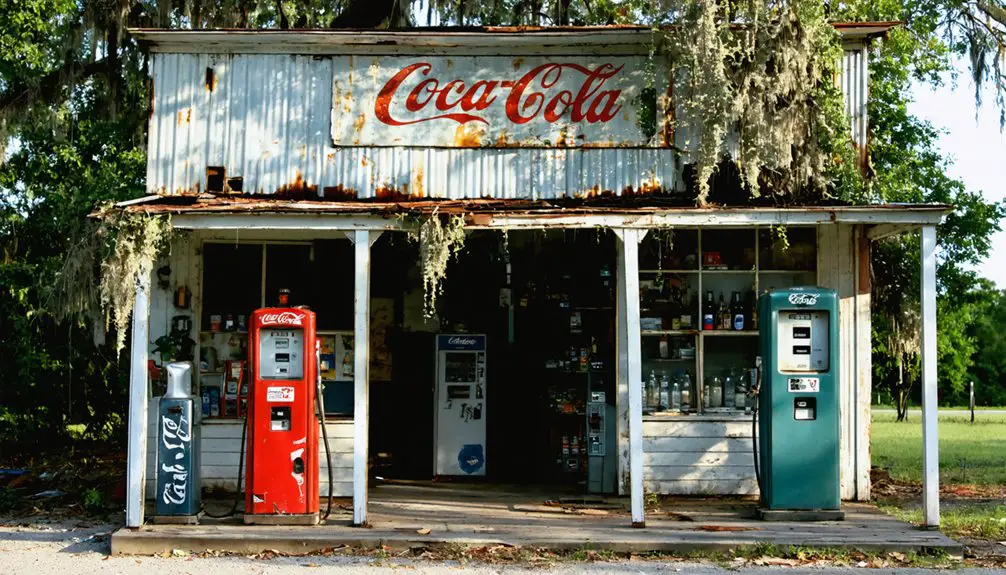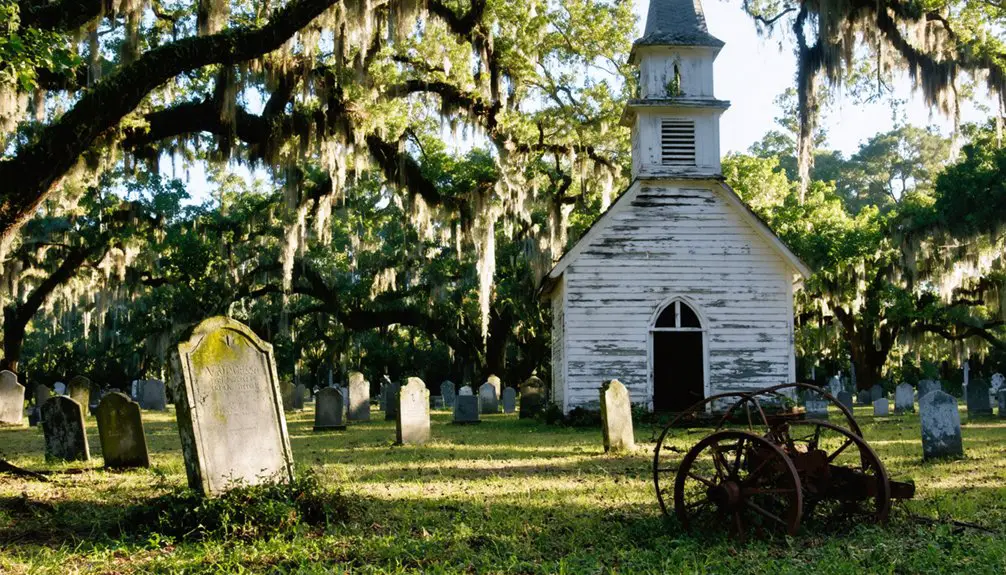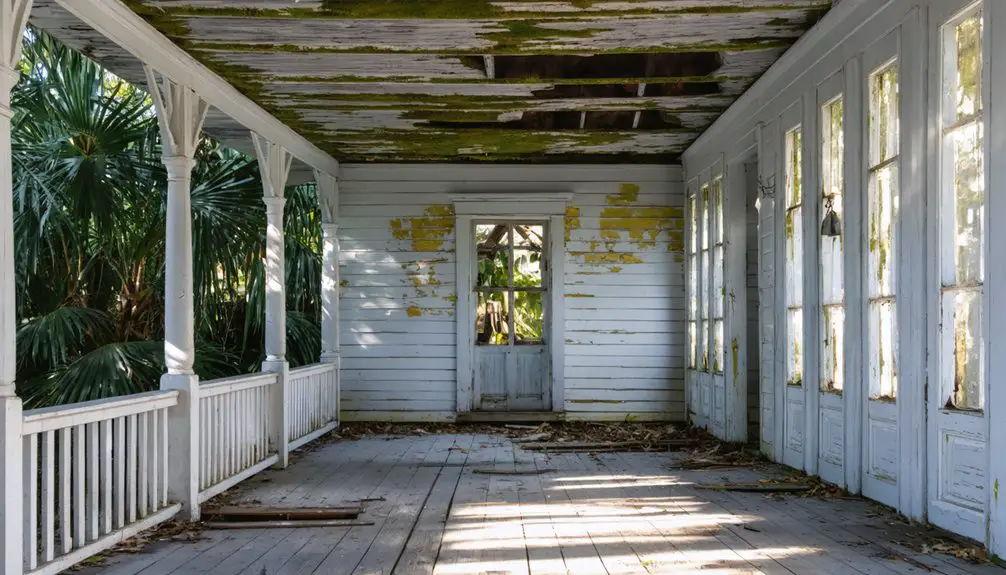You’ll find Sardis nestled in Florida’s historic Manatee County, where this 1850s frontier settlement once thrived among pine forests and natural springs. The town’s economic heart was its sawmill operations until 1898, when a devastating fire marked the beginning of its decline. Today, only the Sardis Cemetery remains between Clay Gully Road and M&J Road, its weathered headstones and period-specific funerary art telling the story of Florida’s pioneering spirit and the complex forces that transformed a bustling community into a ghost town.
Key Takeaways
- Sardis was a 1850s Florida settlement centered around Stomp Springs that became a ghost town after the devastating sawmill fire of 1898.
- The community’s economy relied heavily on sawmill operations, making it vulnerable when the industry collapsed.
- Natural disasters, rising sea levels, and environmental challenges contributed significantly to the town’s eventual abandonment.
- Today, only the Sardis Cemetery remains between Clay Gully Road and M&J Road in Manatee County, Florida.
- The settlement’s decline serves as a cautionary tale about the risks of single-industry dependence in community development.
The Rise of a Florida Frontier Town
As settlers pushed into Florida’s frontier regions in the 1850s, the small community of Sardis took root amid a landscape of pine forests, palmettos, and natural springs.
You’ll find that early settlement patterns centered around Stomp Springs and fertile farming lands, where pioneers first gathered to worship under a simple palmetto shelter.
The town’s community identity quickly formed around its church and school, built as a single structure near what would become the town cemetery.
These institutions served as the heartbeat of frontier life, while nearby stagecoach routes connected Sardis to crucial trade networks.
Local farmers worked the land, establishing homesteads and cultivating crops suited to Florida’s soil. Much like the ancient Lydian artisans who specialized in crafting jewelry and seals, the settlers developed their own unique skills to sustain their community.
Similar to the thriving pineapple plantations that would later define Viking, Florida, these early settlers experimented with various agricultural ventures.
They built modest wooden structures using materials from the surrounding wilderness, creating a self-reliant frontier outpost.
Daily Life and Community Spirit
Three pillars defined daily life in frontier Sardis: faith, education, and community bonds.
You’d find residents worshiping and learning under a shared church-school building, where community gatherings strengthened neighborly ties. The building, erected in the 1850s just west of the cemetery, served as the heart of local life, reflecting the settlers’ commitment to shared resources and collective growth. Much like the bustling sawmill industry of other Florida towns, Sardis relied on local resources to sustain its economy.
The shared church-school building stood as Sardis’ beating heart, where worship, learning and fellowship wove the community’s social fabric together.
- You’d witness children studying their lessons by day, while the same space transformed for worship services.
- Families worked together during harvests, sharing tools and labor to guarantee everyone’s crops came in.
- Neighbors gathered for social events that merged practical work with community celebration.
- The cemetery, still visible today, stands as a reflection of the deep family connections that bound Sardis together.
The pioneering residents eventually moved to larger towns during economic hardship, following a pattern similar to many rural communities of the era.
The Town’s Economic Backbone
You’ll find that Sardis’s economic heart pumped steadily through its sawmill operations until 1898, when a devastating fire destroyed the facility and dealt a severe blow to the town’s prosperity.
The mill had served as both a major employer and a hub for processing the region’s abundant timber resources, drawing workers and their families to settle in the growing community.
Local commerce flourished during the mill’s operational years, with small-scale farmers and merchants establishing a network of trade that supported the town’s expanding population. Like many communities dependent on extractive industries, Sardis followed the familiar pattern of rapid rise and decline seen throughout Florida’s early development. The area’s agricultural potential remained untapped as the region failed to transition to diverse farming crops, unlike other parts of Florida that successfully shifted their economic base.
Sawmill Operations and Industry
Steam-powered sawmills transformed Sardis into a bustling industrial hub during Florida’s lumber boom of the early 1900s.
You’ll find that sawmill innovations revolutionized timber harvesting, with operations utilizing both traditional and mechanized methods to extract and process lumber. The introduction of steam engines and circular saws dramatically increased production capacity, while specialized locomotives transported logs across carefully planned tram road networks. The mills operated under hazardous conditions, as “No Smoking” signs were frequently disregarded, leading to numerous mill fires. The mills achieved remarkable efficiency with a daily capacity of 150,000 feet of timber.
- Up to fifteen steam locomotives hauled timber through the area’s logging railroad system
- Portable steam skidders extracted valuable cypress logs from swampy terrain
- African American workers from Georgia, Alabama, and North Florida formed the backbone of the labor force
- Company-provided housing supported workers and their families around the mill site
These industrial advances helped Sardis compete in regional and national lumber markets, though the demanding and often dangerous work took its toll on the workforce.
Local Trade and Commerce
While sawmills drove Sardis’s industrial growth, the town’s economic backbone rested on a complex network of company stores and controlled commerce.
You’d find these stores as the primary retail outlets, where workers spent their wages – often paid in scrip that could only be used at company establishments. This created a system of company dependence that kept economic power firmly in employers’ hands. The Sherman Mill Company planned extensive operations that expanded the local population from dozens to around 150 residents. Similar to Richwoods’ decline after the mill closures in the early 1990s, Sardis faced economic hardship.
The town’s trade limitations extended beyond retail.
Though railroads connected Sardis to broader markets, the company’s commercial dominance restricted independent merchants. Essential goods like food, clothing, and lumber supplies flowed through company-controlled channels.
As resource extraction intensified, this economic model proved unsustainable. The cycle of boom and bust, coupled with resource depletion, eventually contributed to the town’s decline.
Natural Disasters and Environmental Challenges
Like many coastal settlements in Florida, Sardis fell victim to nature’s relentless assault through devastating hurricanes, rising seas, and environmental degradation.
Natural disasters repeatedly battered the town’s structures, while environmental challenges from rising sea levels accelerated its decline. You’ll find evidence of this struggle in the changing landscape, where saltwater intrusion has transformed once-thriving ecosystems into ghost forests of dead vegetation.
- Hurricanes and severe storm surges repeatedly demolished homes and infrastructure
- Rising sea levels led to increased flooding frequency and severity
- Saltwater intrusion killed native plants, including hardy sabal palms
- Loss of protective natural barriers like mangroves and marshes hastened erosion
These combined forces ultimately proved too powerful for Sardis’ residents to overcome, contributing greatly to the town’s abandonment.
The Path to Abandonment

The devastating forces of nature weren’t the only factors that sealed Sardis’s fate. The catastrophic sawmill fire of 1898 triggered a chain of economic challenges that would prove insurmountable for this small Florida community. Without industrial diversification, the town couldn’t recover from losing its primary employer.
You’ll find that Sardis’s isolation played a significant role in its demise. Limited transportation infrastructure and declining rail service cut the town off from essential commercial opportunities.
Meanwhile, population decline accelerated as younger residents sought better prospects in urban areas. The Great Depression dealt the final blow, discouraging any chance of new investment.
Large-scale agricultural changes transformed the surrounding landscape, as mechanized farming replaced traditional family operations. These combined pressures ultimately pushed Sardis past the point of no return.
Cemetery: A Testament to Lost History
Nestled between Clay Gully Road and M&J Road in Manatee County, Sardis Cemetery stands as one of the last visible remnants of this vanished Florida settlement. The cemetery’s grave markers tell stories of the hardy pioneers who built their lives here in the 1800s, before the community’s abandonment around 1895.
Its cultural significance extends beyond mere headstones, offering insights into the social fabric of early Florida settlers.
- Weathered tombstones dating from the early to late 1800s showcase period-specific funerary art, including weeping willows and pointing fingers.
- Family names etched in stone match local landmarks, revealing deep community connections.
- Infant graves from the 1890s testify to the harsh realities of frontier life.
- The cemetery’s layout and marker styles reflect the socio-economic diversity of Sardis’s residents.
Legacy and Lessons From a Forgotten Settlement

While Sardis now stands silent beneath Florida’s subtropical growth, its legacy offers vital lessons about community resilience and development patterns in the American Southeast.
You’ll find that Sardis’ story mirrors many Florida ghost towns, where economic hardships and environmental challenges proved too formidable for early settlers to overcome.
The town’s abandonment serves as a cautionary tale about the fragility of settlements dependent on single industries or agricultural ventures.
Settlements built on narrow economic foundations often crumble, leaving only memories and lessons about sustainable community development.
Today, Sardis’ cultural heritage lives on through its landscape and remnants, teaching valuable lessons about sustainable community planning.
You can see how economic diversification and environmental adaptation are essential for long-term survival.
The site’s ongoing preservation challenges highlight the delicate balance between honoring historical spaces and meeting modern development needs.
Frequently Asked Questions
Are There Any Surviving Photographs of Sardis During Its Peak Years?
You won’t find surviving historical documentation or photographic evidence from Sardis’ peak years. Neither local archives, historical societies, nor digital collections have preserved images of this lost Florida settlement.
What Happened to the Residents’ Homes and Possessions After Abandonment?
You’ll find most abandoned belongings deteriorated naturally from weather and wildlife, while property ownership records suggest some residents took valuables when leaving. Time and nature eventually reclaimed the remaining structures.
Were There Any Notable Crimes or Murders Recorded in Sardis?
You won’t find documented Sardis crimes or murders in historical records. The town’s abandonment appears linked to economic decline rather than violence, though incomplete records mean you can’t rule anything out entirely.
Did Any Famous or Historically Significant People Originate From Sardis?
You won’t find any famous residents or historically significant people originating from this settlement. Records show only ordinary community members who gathered for worship and schooling under a palmetto-roofed shelter.
Are There Ongoing Efforts to Preserve or Restore Any Sardis Structures?
Like a fading photograph, you’ll find no active restoration efforts currently underway. While the county documents local history through media and oral histories, preservation challenges and funding limitations prevent physical structure rehabilitation work.
References
- https://www.youtube.com/watch?v=0kzAaaal1X0
- https://www.ghosttowns.com/states/fl/sardis.html
- https://www.tiktok.com/@socialshepherdadventures/video/7342301852702100778
- https://www.onelook.com/thesaurus/?s=sardis&senseid=774241073
- https://www.tiktok.com/discover/sardis-lake-history
- https://en.wikipedia.org/wiki/Sardis
- https://www.youtube.com/watch?v=TxBONhwNi1k
- https://www.randomconnections.com/exploring-jacks-township/
- https://www.randomconnections.com/renno-revisited/
- https://www.youtube.com/watch?v=fAu5kj5Q5uo



